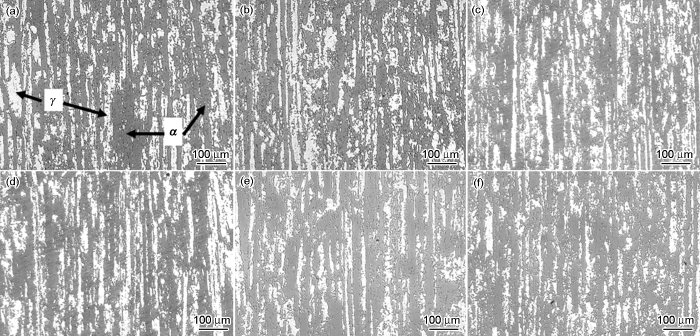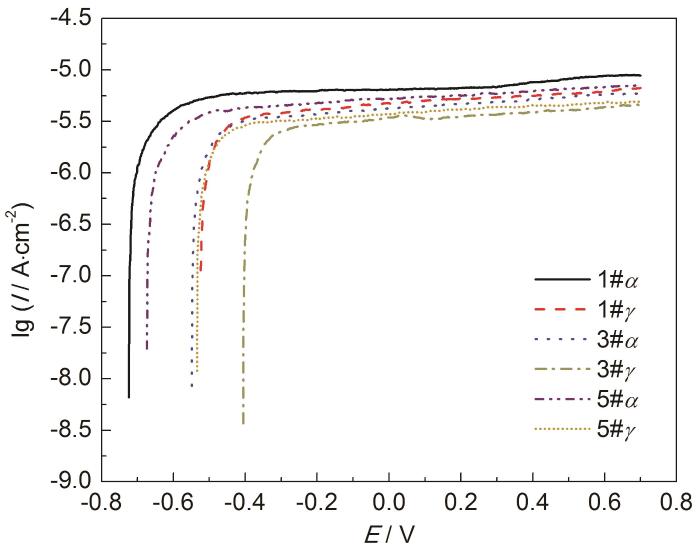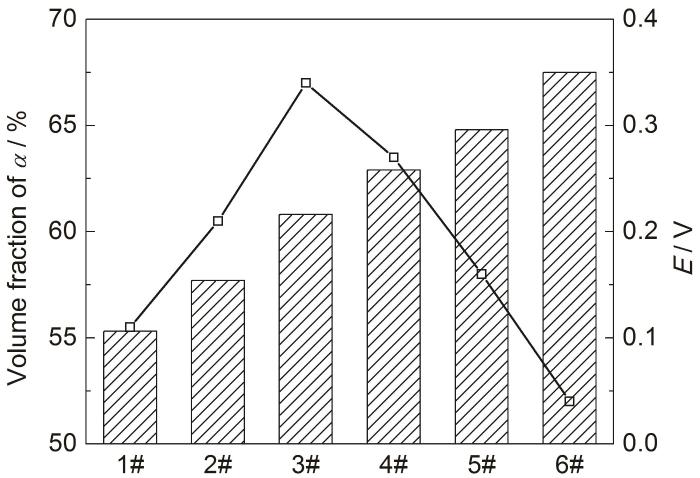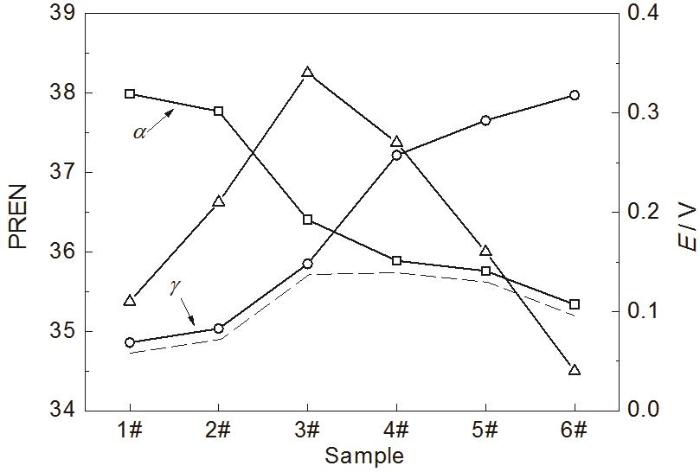不锈钢在服役过程中,点蚀是导致其腐蚀失效的主要形式之一。目前,有关不锈钢点蚀萌生机制的研究多集中于夹杂物[7-9]、析出相[10-12]等的影响。本课题组前期研究氧化物夹杂引发2205双相不锈钢点蚀萌生时表明,由于铁素体相和奥氏体相的晶体结构、化学组成的不同导致其电化学活性的差异,使得同一类氧化物夹杂在铁素体相和奥氏体相上引发点蚀的能力并不相同[13]。事实上,在双相不锈钢热处理过程中,合金元素在两组成相中重新分配,两相占比明显改变,会对样品的点蚀抗性产生显著影响。Zhang等[14]通过对UNS S32304进行退火处理研究两相占比对双相不锈钢点蚀抗性的影响,认为不同两相比下点蚀抗性不同且点蚀弱相也不相同。Chen等[15]通过改变2034双相不锈钢的冷却速度研究热影响区中两相比和点蚀抗性的关系,认为其点蚀抗性由点蚀弱相铁素体相的耐点蚀当量 (PREN) 决定。然而,关于双相不锈钢组织配分对点蚀抗性的影响机制的研究还不够系统和深入。因此,本研究通过热处理得到两相占比和元素含量不同的2205双相不锈钢试样,采用点蚀电位测试、点蚀密度统计和微区极化曲线等,研究组织配分对双相不锈钢微区电化学活性及整体点蚀抗性的影响,对于深入理解双相不锈钢的点蚀萌生机制并提出针对性的防护措施具有明显的理论及实际意义。
1 实验方法
样品为宝武集团提供的2205双相不锈钢轧板,其化学成分 (%,质量分数) 为:C 0.018,Cr 22.14,Ni 5.31,Si 0.66,Mn 1.47,P 0.04,S 0.004,N 0.21,Mo 3.09,Fe余量。电化学测试用试样尺寸为ϕ11.3 mm×3 mm,将试样焊接铜导线后用环氧树脂封装,然后用180~2000#砂纸逐级打磨试样工作面,最后在水、酒精和丙酮中清洗后吹干。
电化学测试在CS150H型电化学工作站上进行,电化学测试溶液为3.5% (质量分数) NaCl溶液,电化学腐蚀溶液为30%NaOH溶液。如无特殊说明,实验温度由恒温水浴锅控制在 (30±1) ℃。
电化学测试前先向溶液中通入30 min氮气除氧,并在实验过程中持续通入氮气。先将试样在-1.3 V下极化3 min,接着进行开路测试30 min。动电位扫描时,将实验装置进行60 ℃水浴,设定扫描范围-0.5~0.5 V,扫描速率0.33 mV/s,取电流密度达10-5 A/cm2对应的电位为点蚀电位。恒电位极化时,设置极化电位为2 V,极化时间为10 s。完成后统计点蚀坑数目及尺寸。
利用本课题组自制的毛细管微电极进行微区电化学实验[16]。毛细管工作孔径约为60 μm,毛细管内填装Ag/AgCl作为参比电极,Pt丝作为对电极,试样先在-1.3 V电位下极化3 min,开路电位下稳定30 min后进行阳极扫描,扫描速率为1 mV/s。
将试样在30%NaOH溶液中在3 VSCE下恒电位极化5 s,用蒸馏水、酒精冲洗,并置于丙酮中超声清洗3 min。采用金相显微镜和超景深三维显微镜 (VHX-5000) 对2205双相不锈钢的微观组织形貌进行观察。通过能谱仪 (EDS,INCA IE 350 PentaFET-3) 检测各合金元素在单个组成相中的含量。
2 实验结果
2.1 金相组织观察和元素分布
图1为经过不同温度固溶处理后6种试样的金相组织图。图中亮色的组织为奥氏体 (γ相),暗色的为铁素体 (α相)。可以看到,随着固溶处理温度升高,α相占比逐渐升高,γ相占比降低。
图1
图1
2205双相不锈钢的金相组织
Fig.1
Microstructures of 2205 DSS: (a) 1#, (b) 2#, (c) 3#, (d) 4#, (e) 5#, (f) 6#
6种试样中两组成相占比及主要合金元素含量的分析结果列于表1中。α相占比随着固溶处理温度升高由55.3%逐渐升高至67.5%。两组成相中主要合金元素含量随着固溶处理温度升高发生明显变化,α相中主要耐蚀合金元素Cr和Mo整体上呈现出下降的趋势,而γ相中Cr、Mo和N含量整体呈现出上升的趋势。
2.2 点蚀电位
表1 6种试样中两组成相占比及主要合金元素含量
Table 1
| Sample | Solution temperature / ℃ | Phase | Volume fraction / % | Average mass fraction / % | ||
|---|---|---|---|---|---|---|
| Cr | Mo | N | ||||
| 1# | 1000 | α | 55.3 | 23.00 | 4.30 | 0.05 |
| γ | 44.7 | 20.13 | 2.49 | 0.407 | ||
| 2# | 1050 | α | 57.7 | 23.11 | 4.20 | 0.05 |
| γ | 42.3 | 20.78 | 2.23 | 0.431 | ||
| 3# | 1100 | α | 60.8 | 22.90 | 3.85 | 0.05 |
| γ | 39.2 | 20.72 | 2.33 | 0.465 | ||
| 4# | 1150 | α | 62.9 | 22.78 | 3.73 | 0.05 |
| γ | 37.1 | 21.35 | 2.35 | 0.507 | ||
| 5# | 1200 | α | 64.8 | 23.51 | 3.47 | 0.05 |
| γ | 35.2 | 21.42 | 2.39 | 0.518 | ||
| 6# | 1250 | α | 67.5 | 22.46 | 3.66 | 0.05 |
| γ | 32.5 | 20.86 | 2.36 | 0.561 | ||
2.3 点蚀密度统计
图4
图4
恒电位极化后6种试样表面点蚀形貌
Fig.4
Corrosion morphologies of six samples after potentiostatic polarization: (a) 1#, (b) 2#, (c) 3#, (d) 4#, (e) 5#, (f) 6#
图5
2.4 微区极化曲线
图6
图6
1#、3#和5#试样中两组成相上的微区极化曲线
Fig.6
Micro-potentiodynamic polarization of single phases of 1#, 3# and 5#
图7
图7
3#试样微区极化测试后两组成相上的腐蚀形貌
Fig.7
Corrosion morphologies of 3# sample after micro-potentiodynamic polarization: (a) α, (b) γ
3 讨论
图2
图2
6种试样在60 ℃ 3.5%NaCl溶液中的极化曲线
Fig.2
Polarization curves of six different 2205 DSS samples in 60 ℃ 3.5%NaCl solution
图3
表2 1#、3#和5#试样微区极化曲线拟合参数
Table 2
| Sample | Phase | Ecorr / V | Icorr / μA·cm-2 |
|---|---|---|---|
| 1# | α | -0.72 | 5.66 |
| γ | -0.53 | 3.44 | |
| 3# | α | -0.55 | 3.07 |
| γ | -0.41 | 2.56 | |
| 5# | α | -0.67 | 3.86 |
| γ | -0.54 | 2.82 |
图8
当两相偶合之后,α相作为阳极,γ相作为阴极,两相相互极化至偶合电位Eg。α相的阳极电流密度I1,以及γ相的阴极电流密度I2,可以根据下式计算:
这里Ecorr1和Ecorr2分别是α相和γ相的自腐蚀电位,Icorr1和Icorr2分别是α相和γ相的腐蚀电流密度,βa1,βc1,βa2,βc2分别是发生在α相和γ相上的阴阳极反应的Tafel斜率。于是,α相和γ相之间的偶合电流Ig通过下式得到:
这里A1和A2分别为α相和γ相的面积。γ相受到阴极极化,因此Eg-Ecorr2<0,假设Eg偏离Ecorr1和Ecorr2足够远,则
偶合之后α相的阳极溶解电流密度ia1 (ia1越大微电偶效应越强) 可表示为:
将等
从等
表3 影响两相间微电偶效应的部分参数
Table 3
| Sample | Icorr1μA·cm-2 | Icorr2μA·cm-2 | Ecorr2-Ecorr1V | A2 / A1 |
|---|---|---|---|---|
| 1# | 5.66 | 3.44 | 0.19 | 0.81 |
| 3# | 3.07 | 2.56 | 0.14 | 0.64 |
| 5# | 3.86 | 2.82 | 0.13 | 0.54 |
4 结论
(1) 通过固溶处理对双相不锈钢组织配分,当固溶温度由1000 ℃上升到1250 ℃时,2205双相不锈钢中α相体积分数由55.3%持续上升至67.5%,主要合金元素向γ相中聚集。当α相占比为60.8%时,双相不锈钢具有最高的点蚀电位和最低的点蚀密度。
(2) 合金元素在α和γ两相中的分配以及两相的占比对两相的微区电化学活性及两相间的电偶效应产生影响。当α相占比为60.8%时,两相具有最高的自腐蚀电位、最低的自腐蚀电流密度和最弱的微电偶效应,此时2205双相不锈钢具有最高的点蚀抗性。
参考文献
Development and trend of hyper duplex stainless steels
[J]. J.
特超级双相不锈钢的发展现状及趋势
[J].
Research progress of economic type duplex stainless steel welding
[J].
经济型双相不锈钢焊接的研究进展
[J].
Control on microstructures and properties of economical duplex stainless steel and its manufacturing technology
[J].
节约型双相不锈钢组织性能控制与制造技术
[J].
Progress of the application of duplex stainless steel at home and abroad
[J].
国内外双相不锈钢的应用进展
[J].
Development of duplex stainless steel, characteristics and applications
[J].
双相不锈钢的发展、特点及其应用
[J].
Analysis on composition, properties and precipitated phases of duplex stainless steel
[J].
双相不锈钢成分、性能及析出相分析
[J].
Pitting at the δ/γ boundary of type 304 stainless steel in NaCl solution: The role of oxide inclusions and segregation
[J]. J.
Mechanism of (Mg, Al, Ca)-oxide inclusion-induced pitting corrosion in 316L stainless steel exposed to sulphur environments containing chloride ion
[J].
Effects of electropulsing on inclusion size and corrosion-resistance of 304 stainless steel
[J].
Effect of aging treatment on the pitting corrosion resistance of 2205 duplex stainless steel
[J].
时效处理对2205双相不锈钢耐点蚀性能的影响
[J].
Impact toughness, fatigue crack growth and corrosion behavior of thermally aged UNS S32205 duplex stainless steel
[J].
Study on the corrosion behavior of economical duplex stainless steel 2101
[D].
经济型双相不锈钢2101的腐蚀行为研究
[D].
Investigation of micro-electrochemical activities of oxide inclusions and microphases in duplex stainless steel and the implication on pitting corrosion
[J].
Microstructural evolution and pitting resistance of annealed lean duplex stainless steel UNS S32304
[J].
Influence of cooling rate on microstructure evolution and pitting corrosion resistance in the simulated heat-affected zone of 2304 duplex stainless steels
[J].
Parameter optimization for capillary microelectrode preparation
[J]. J.
毛细管微电极制备参数优化
[J].
Effect of post-weld heat treatment on microstructure evolution and pitting corrosion behavior of UNS S31803 duplex stainless steel welds
[J].
Effect of prolonged thermal cycles on the pitting corrosion resistance of a newly developed LDX 2404 lean duplex stainless steel
[J].
Microstructure evolution and pitting corrosion resistance of the Gleeble-simulated heat-affected zone of a newly developed lean duplex stainless steel 2002
[J].
Interpretation of the relation between ferrite fraction and pitting corrosion resistance of commercial 2205 duplex stainless steel
[J].
Understanding the relation between phase fraction and pitting corrosion resistance of UNS S32750 stainless steel
[J].












